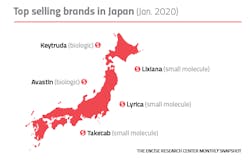Editor's Note: Global Dose is a new editorial feature that will examine the state of pharma beyond the borders of the United States, exploring the pluses and minuses of different economies, governments, climates, workforces, and regulatory requirements. Each month, this feature section will focus on the ins and outs of the pharma industry in a different country or region.
A recent industry trend report referred to Japan’s pharma market as “ambivalent: torn between two equal but opposing forces.”1 One might argue that there are several competing forces at play when it comes to the unique dynamics of pharmaceuticals in Japan. While the country’s market has amazing potential, it also presents its own distinct obstacles and complexities.
Currently, economists warn that Japan is on the brink of recession. Novel coronavirus outbreaks in Asia have added additional economic stress. Yet, Japan continues to be one of the largest pharma markets in the world. Takeda Pharmaceutical’s $62 billion acquisition of Shire in 2019 propelled the Japanese drugmaker onto the list of global top 10 pharma companies and made a loud statement about Japan pharma’s readiness to expand its reach.
A 6,852-island archipelago, the entire country of Japan has fewer square miles of land than California. Historically, Japan’s mountainous terrain and lack of mineral resources meant potential for industry was limited. As such, the country relied heavily on the sea for resources and trade.While it dictated the development of industry, Japan’s remote location also encouraged isolation — even now, the population remains extremely homogenous with its own distinct culture. In terms of business, this culture is notoriously challenging for outsiders and this, coupled with the high standards of Japanese consumers, has made the market difficult to penetrate. But at the same time, a rapidly aging population has created a growing demand for medications, many of which will need to be supplied by foreign drugmakers.
The market
The wider economy in Japan is currently slumping, and this has largely been attributed to the impact of a devastating typhoon and a sales tax increase last October. Japan, with its population hovering around 127 million, has the highest national debt ratio in the world at 234 percent of its GDP (for comparison, the U.S. ratio is 107 percent).2
Despite this, Japan’s economy still ranks as the world’s third largest, after the U.S. and China. The pharma market so far has fared OK in this trying economic time, reporting 4.4 percent growth in the past month.3 The CPhI Japan 2019 market report predicted the country’s market for drugs will continue to grow, driven by an increase in demand for solid dose formulations and growth in generics. Japan remains one of the most important economic partners for the U.S. in pharmaceuticals and beyond.
The Japanese market for prescription and nonprescription pharmaceuticals in 2018 totaled $87 billion. The U.S. is Japan’s No. 1 pharma trading partner, with 22 percent of Japan’s pharma exports going to the U.S. and 23.5 percent of its imports coming from the U.S.4
Drug pricing and innovation
Japan is home to the world’s oldest population — almost one third of its population is over the age of 65 (in the U.S. about one seventh of the population is over 65). The aging population is putting pressure on the nation’s health care system, causing a surge in spending. Compounding this issue, last year the birth rate in Japan reached its lowest point in recorded history (since 1899). A shrinking younger population means fewer people fueling the tax base used to fund the health care system.
These factors have resulted in ongoing efforts by the Japanese government to control costs.
Unlike the “free market” pricing structure in the U.S., drug prices in Japan are determined by the Ministry of Health, Labor, and Welfare (MHLW) and subsidized by the country’s public health insurance system. In an attempt to control health care costs, the government has been revising drug prices every two years.
The pricing environment in Japan has historically been considered tough for foreign-based drug companies looking to launch innovative drugs on the Japanese market. Because novel drugs often lack a benchmark for pricing, many pharma companies have found themselves launching new drugs in EU or U.S. markets first to establish price points, and then bringing the innovation to Japan.6
In 2010, the Japanese government implemented the Price Maintenance Premium (PMP) system, with the stated goal of creating a stable and reliable pricing situation for innovators. The system added price premiums to innovative drugs and protected new drugs from price cuts throughout their period of exclusivity. This created a more attractive environment for innovative pharma companies, reducing the time elapsed between when a drug became available outside Japan versus in Japan.
But as new, pricier drugs flooded the Japanese market, government spending on pharmaceuticals began to rise. In response, the government overhauled the PMP in April 2018. The reform drastically limited the scope of the system, creating a more narrow definition of innovation — as such, the country saw a 32 percent drop in the amount of drugs meeting the criteria needed to be included on the PMP list in 2018.7 This meant that fewer products would be exempt from mandatory repricing. Additionally, the reform stated that beginning in 2021, drugs in Japan would be subject to mandatory repricing every year. Needless to say, the global pharma industry was not happy with the 2018 reforms.
As the government continues to evaluate and reform the pricing policy, it remains to be seen what impact it will have on innovation and overall investment in the market.
Regulatory
The MHLW oversees food and drugs in Japan. In conjunction with the MHLW, the Pharmaceutical and Medical Device Agency (PMDA) is responsible for reviewing drug and medical device applications (similar in function to the U.S. FDA).
Like the FDA, the PMDA offers both standard and priority review designations. In Japan, drug products granted orphan drug designation are automatically granted priority review (not the case in the U.S.). Japan’s version of breakthrough therapy designation is called “Sakigake.” This designation prioritizes the approval of products treating diseases with unmet medical needs and that satisfy two conditions: (1) The medical product was first developed in Japan, and has a sponsor that’s planning to submit a marketing authorization application; and (2) early phase clinical studies, non-clinical studies, and the mechanism of action suggest prominent effectiveness.8 Notably, the first requirement of the Sakigake designation gives a distinct advantage to Japanese companies. As of May 2019, over 75 percent of treatments granted Sakigake designation were developed by Japanese companies.
Another important regulatory change in Japan is the gradual implementation of a health technology assessment (HTA) process. A tool used to control government spending on health care, HTA is a formal research process designed to evaluate medical treatments or innovations. The information gathered is then used to inform coverage and policy decisions.9 In the UK, for example, the National Institute for Health and Care Excellence (NICE) conducts HTA to help the National Health Systems assess value and decide which treatments should be covered.
Lacking its own governmental HTA, Japan launched a two-year pilot program in 2016. This involved the creation of the Central Social Insurance Medical Council (Chuikyo) to provide recommendations on pricing to the MHLW. Beginning in April 2019, the submission of cost-effectiveness evidence to the Chuikyo became mandatory for selected drugs and medical devices. The MHLW has slowly broadened the amount of therapies included in its HTA program. Earlier this year, much to the disappointment of numerous drugmakers, Chuikyo approved a drug repricing system that reduced prices on 17 drugs, among them blockbusters from Merck & Co. (Keytruda) and Daiichi Sankyo (Lixiana).
Generics and biosimilars
The Japanese government’s quest to cut health care spending has encouraged growth in the generic and biosimilar sectors.
Generics initially struggled in Japan, largely due to the prevailing consumer belief that generics are inferior to branded drugs, regulatory approval backlogs and pushback from major drug distributors. In 2007, the government began setting market penetration goals for generics — the industry met the initial goal of 30 percent by 2013, and the new target was set at 80 percent by the end of 2020.10 A report released in fall of 2019 by the International Generic and Biosimilar Medicines Association noted that Japan has a generic market share of 73 percent. (The U.S. is at 90 percent.)
Japan’s increased use of biologics — which often come with higher development and manufacturing costs, as well as higher price tags — has contributed to the growing health care burden. As such, biosimilars have begun to gain footing, albeit slowly. In March 2009, guidelines for biosimilars, based on the EU’s existing processes, were published by the MHLW. Shortly thereafter Sandoz’s growth hormone treatment Somatropin BS won the first biosimilar approval. Now with 21 approved biosimilars, the majority of which are cancer-related, Japan still lags behind both Europe (66) and the U.S. (26).
Unanticipated obstacles
In addition to somewhat predictable economic and governmental challenges, the pharma industry in Japan has had to deal with frequent natural disasters, as well as epidemics.
Typhoon Hagibis pummeled Japan last October, killing at least 90 people and leaving companies dealing with extensive flooding and power loss. Fortunately, the pharma sector was one of the lucky ones, and escaped without major drug supply disruptions following the storm.
In the past few weeks, earthquakes ranging in magnitude have struck various regions throughout Japan. In addition to damage from the earthquake itself, the bigger threat surrounding earthquakes in Japan is their tendency to cause tsunamis. Such was the case in March 2011, when an earthquake and resulting tsunami traveling close to 500 mph with 32-foot-high waves swept over the east coast of Japan, killing more than 18,000 people. The tsunami caused a nuclear crisis at the Fukushima Nuclear Complex, radioactive contamination, evacuations, massive structural damage and loss of electricity — in total, between $195 billion and $305 billion in physical damage. Several major pharma companies and distributors reported serious damage, disrupting supply chains and causing nationwide drug shortages.
Currently, the novel coronavirus outbreak is also affecting the markets in Japan — the country’s close proximity to China makes the outbreak particularly impactful. According to the Japan National Tourism Organization, Japan welcomed 8.1 million Chinese tourists last year. Many major manufacturers in Japan (such as Honda and Nissan) have factories in Wuhan, China. And like the U.S., the Japanese pharma industry sources much of its raw materials from Chinese suppliers.
At the time of writing, there were approximately 470 confirmed cases of COVID-19 in Japan, as well as the 639 cases from the Diamond Princess cruise ship that was quarantined in Yokohama. Japanese health officials are taking precautions, closing schools and postponing major events.
The participation race for the Tokyo marathon, which was expected to include 38,000 runners, was limited to 200 elite athletes. CPhI Japan, a major pharma industry tradeshow originally scheduled for mid-march in Tokyo, was postponed due to outbreak-related travel restrictions. All eyes are now on the XXXII Olympic Summer Games, which are scheduled to take place in Tokyo in late July.
Japan has a reputation for innovation, especially in manufacturing. Given this, most are optimistic that the pharma sector will survive economic headwinds and iron out its drug pricing structure, keeping it an important destination for foreign pharma companies. At the same time, continued growth in the generics sector promises to provide relief in health care spending. Overall, the market continues to play an important role in the global pharma industry.
References
1. CPhI Japan Trend Report 2019. Informa Markets.
2. Debt to GDP Ratio by Country 2020. World Population Review. Accessed: Feb. 21, 2020.
3. McMillan, Alex. Japan’s Economy Sicker Than Expected and Before Any Virus Effect. Real Money. Feb 19, 2020.
4. Summary of Annual Statistics on Production Dynamics of 2018 Pharmaceutical Industry. Japan’s Ministry of Health, Labor and Welfare.
5. Population ages 65 and above - Japan, United States. The World Bank. Accessed: Feb 21, 2020.
6. Japan’s Ongoing Shift From a Traditional Reimbursement Assessment. Xcenda. September 12, 2018.
7. Haydock, Ian and Fulton, Zara. Japan Pharma Outlook Webinar Recording. Pharma Intelligence. June 2018.
8. Nagai, Sumimasa. Flexible and Expedited Regulatory Review Processes for Innovative Medicines and Regenerative Medical Products in the US, the EU, and Japan. Translational Research Center, The University of Tokyo Hospital, Aug 2019.
9.Timmins, Nicholas. How To Think About Health Technology Assessment. Health Affairs. Sept. 2016.
10. Biosimilars approved in Japan. GaBi. Updated: November 15 2019





